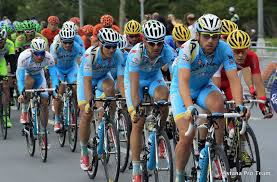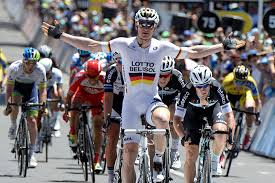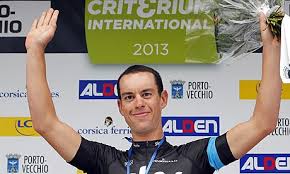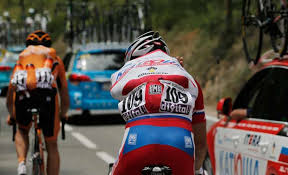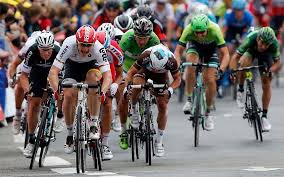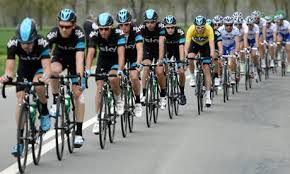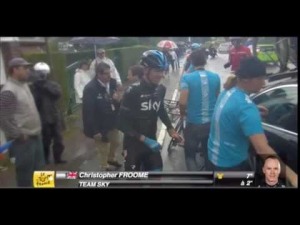The two or three of you who’ve stuck with me through this series on the Tour de France might have noticed that I have tended to talk about the competition in team terms, but the prizes in individual terms. Yep, that’s really how it works. Pro cycling is either the most individualistic of team sports, or the most team-oriented of individual sports; it’s kind of hard to tell which one. There is a prize for the team with the lowest combined time for the Tour, but that prize gets so little attention that I didn’t even bother mentioning it in my ‘How to Win’ post. All of the top prizes in the Tour go to individuals; but those individuals couldn’t possibly win without an entire retinue working its hardest to put them in a place to succeed.
Twenty-two nine-person teams start the Tour de France (when I talk about 200 riders, I’m rounding. There are 198 riders on the starting line the first day). I say ‘start’ because if a rider is forced to abandon the race due to injury or faces a time elimination, they aren’t replaced. The team simply has to do with less for the rest of the Tour. Sky, for example, is now down to seven riders.
These teams are built on two different basic models:
- GC Teams–these teams are built around great all-around riders. The ultimate goal for any cycling team is, of course, to have one of their members win the GC. Going into the Tour, Sky, Tinkoff-Saxo, and Astana were the leading GC teams this year; with the injuries to Froome and Contador, only Astana remains as a top GC team. We’ll see if anyone rises up to fill the gap. But many teams go into the Tour knowing that the odds of ending it with a teammate in a yellow jersey are slim to none. They just don’t have the personnel for it. Some of those teams therefore form around a completely different strategy, #2 below. Other teams take what I might call a ‘GC lite’ approach.
- GC lite–the best all-around rider on these teams is still developing, or is on the downward slope of their career, or is simply good but not great. For them, a GC win is realistically out of reach, but they choose intermediate goals on the GC spectrum. They might aim for a podium finish (top 3), or a top 10 finish, or maybe to wear the yellow for just one stage. I’d say Tejay Van Garderen’s team, BMC, went into the Tour with a GC lite strategy; they overtly stated that they’re looking for a top 5 finish. They’re kind of a heavy GC lite, and with those Froome and Contador injuries they could be setting their sights higher now.
- Sprint teams–these teams don’t have an all-around rider who is ready to compete for yellow, but they do have someone who can go very, very, very fast over short distances. These teams aim for stage wins, green points, or both. Marcel Kittel’s Giant-Shimano team, Andrei Greipel’s Lotto-Belisol, and Peter Sagan’s Cannondale team are the big sprint teams this year. Omega Pharma-Quickstep would have been as well, except that their leader Mark Cavendish was injured on stage 1. There’s also something of a ‘Green lite’ strategy, in which a team might focus on grabbing a stage win or two.
Both of these types of teams has riders in three basic positions. It gets way more complicated than this, but I’m drawing the lines crudely.
The Top Man
This is the guy you think can actually take the prize, whether that’s the yellow jersey, the green jersey, or a stage win. You build your whole team and its strategy around this rider. In the final moment of the contest, it’s all up to him.
The Lead Out Men
It’s the job of the lead out men to safely deliver the top man into proper position to compete at the crucial moment. They do this in two ways:
- They protect–when things get sort of skittish in the peloton, the lead out men will actually surround the top man, to minimize the chance of accident or injury;
- They pull–pulling is allowing someone else to draft off of you, which–as I mentioned yesterday–keeps up their speed with a minimum expenditure of energy on their part. When it gets down to the business of the day, the lead out men will form a line in front of the top man, each taking their turn at totally blowing out their own legs to get their top man to the front or keep him there. Ideally, when the last lead out man uses his last gasp of energy, the top man is pretty close to the front with pretty fresh legs.
Team Sky is my favorite team because they are particularly good at developing and giving proper respect to stellar lead out men. Chris Froome was Wiggin’s lead out man. Richie Porte is Froome’s. And with Froome out, Geraint Thomas is rising into Porte’s place.
Domestiques
Domestique is French for ‘servant,’ which pretty much captures the role of these guys on a team. They spend most of their time making deliveries: picking up water bottles for the rest of the team, shuttling rain jackets back and forth between the team car, sometimes passing messages along if there’s a problem with the radio. But it doesn’t stop at deliveries. Absolutely anything that would be helpful is within the scope of a domestique’s job. They will even hand over their bike to the top man or a key lead out man, if there’s a mechanical problem at a crucial moment without a mechanic nearby.
The lead out men and, even more so, the domestiques work very hard, often invisibly, knowing full well that they’re working to get the top prize for someone else. In exchange, they get the satisfaction of a job well done–oh, and the chance to make a living riding a bike. And occasionally, if not much looks like it’s happening among the top GC riders on a given day or there’s no sprint finish for your team to compete in, the lead out men and domestiques might get the day off from the normal duties. Those days, they have a little fun by going out in the break, or trying to win a sprint–or maybe even a stage win–themselves.
